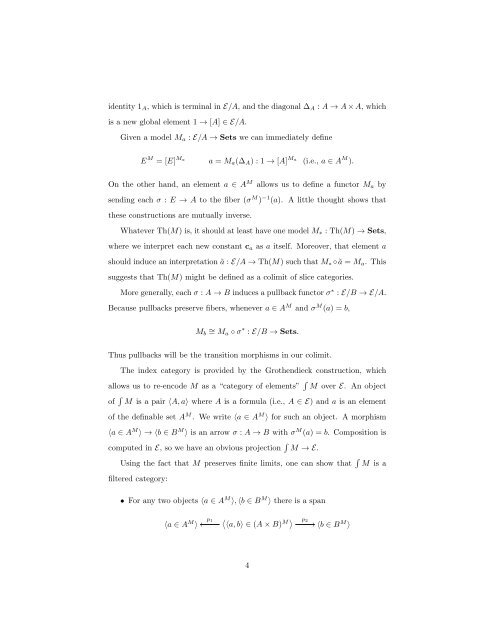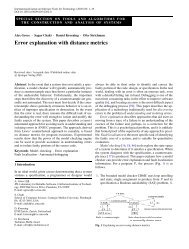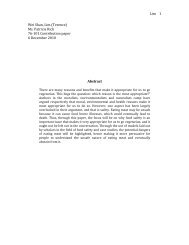A refactored proof of conceptual completeness
A refactored proof of conceptual completeness
A refactored proof of conceptual completeness
Create successful ePaper yourself
Turn your PDF publications into a flip-book with our unique Google optimized e-Paper software.
identity 1A, which is terminal in E/A, and the diagonal ∆A : A → A × A, which<br />
is a new global element 1 → [A] ∈ E/A.<br />
Given a model Ma : E/A → Sets we can immediately define<br />
E M = [E] Ma a = Ma(∆A) : 1 → [A] Ma (i.e., a ∈ A M ).<br />
On the other hand, an element a ∈ A M allows us to define a functor Ma by<br />
sending each σ : E → A to the fiber (σ M ) −1 (a). A little thought shows that<br />
these constructions are mutually inverse.<br />
Whatever Th(M) is, it should at least have one model M∗ : Th(M) → Sets,<br />
where we interpret each new constant ca as a itself. Moreover, that element a<br />
should induce an interpretation ã : E/A → Th(M) such that M∗ ◦ã = Ma. This<br />
suggests that Th(M) might be defined as a colimit <strong>of</strong> slice categories.<br />
More generally, each σ : A → B induces a pullback functor σ ∗ : E/B → E/A.<br />
Because pullbacks preserve fibers, whenever a ∈ A M and σ M (a) = b,<br />
Mb ∼ = Ma ◦ σ ∗ : E/B → Sets.<br />
Thus pullbacks will be the transition morphisms in our colimit.<br />
The index category is provided by the Grothendieck construction, which<br />
allows us to re-encode M as a “category <strong>of</strong> elements” M over E. An object<br />
<strong>of</strong> M is a pair 〈A, a〉 where A is a formula (i.e., A ∈ E) and a is an element<br />
<strong>of</strong> the definable set A M . We write 〈a ∈ A M 〉 for such an object. A morphism<br />
〈a ∈ A M 〉 → 〈b ∈ B M 〉 is an arrow σ : A → B with σ M (a) = b. Composition is<br />
computed in E, so we have an obvious projection M → E.<br />
Using the fact that M preserves finite limits, one can show that M is a<br />
filtered category:<br />
• For any two objects 〈a ∈ A M 〉, 〈b ∈ B M 〉 there is a span<br />
〈a ∈ A M 〉<br />
<br />
p1<br />
〈a, b〉 ∈ (A × B) M <br />
4<br />
p2 <br />
M 〈b ∈ B 〉








